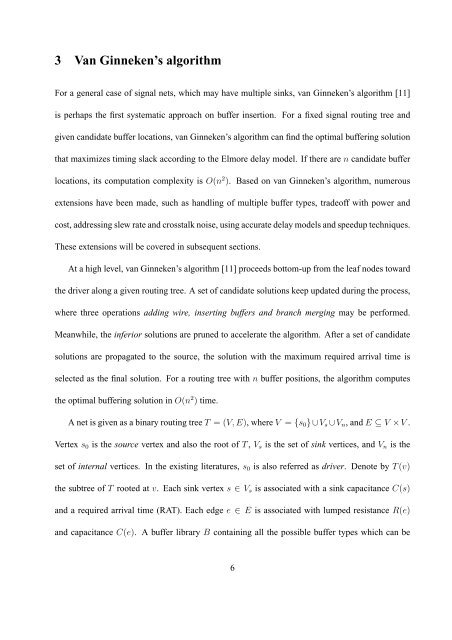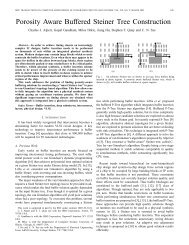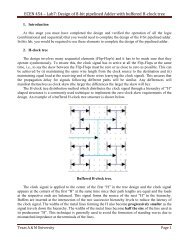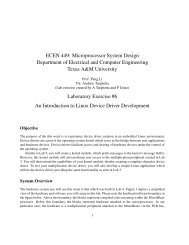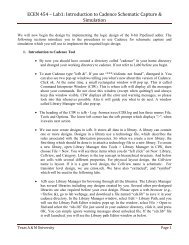Buffer Insertion Basics - Computer Engineering & Systems Group ...
Buffer Insertion Basics - Computer Engineering & Systems Group ...
Buffer Insertion Basics - Computer Engineering & Systems Group ...
You also want an ePaper? Increase the reach of your titles
YUMPU automatically turns print PDFs into web optimized ePapers that Google loves.
3 Van Ginneken’s algorithm<br />
For a general case of signal nets, which may have multiple sinks, van Ginneken’s algorithm [11]<br />
is perhaps the first systematic approach on buffer insertion. For a fixed signal routing tree and<br />
given candidate buffer locations, van Ginneken’s algorithm can find the optimal buffering solution<br />
that maximizes timing slack according to the Elmore delay model. If there are n candidate buffer<br />
locations, its computation complexity is O(n 2 ). Based on van Ginneken’s algorithm, numerous<br />
extensions have been made, such as handling of multiple buffer types, tradeoff with power and<br />
cost, addressing slew rate and crosstalk noise, using accurate delay models and speedup techniques.<br />
These extensions will be covered in subsequent sections.<br />
At a high level, van Ginneken’s algorithm [11] proceeds bottom-up from the leaf nodes toward<br />
the driver along a given routing tree. A set of candidate solutions keep updated during the process,<br />
where three operations adding wire, inserting buffers and branch merging may be performed.<br />
Meanwhile, the inferior solutions are pruned to accelerate the algorithm. After a set of candidate<br />
solutions are propagated to the source, the solution with the maximum required arrival time is<br />
selected as the final solution. For a routing tree with n buffer positions, the algorithm computes<br />
the optimal buffering solution in O(n 2 ) time.<br />
A net is given as a binary routing tree T = (V,E), where V = {s 0 }∪V s ∪V n , and E ⊆ V ×V .<br />
Vertex s 0 is the source vertex and also the root of T , V s is the set of sink vertices, and V n is the<br />
set of internal vertices. In the existing literatures, s 0 is also referred as driver. Denote by T(v)<br />
the subtree of T rooted at v. Each sink vertex s ∈ V s is associated with a sink capacitance C(s)<br />
and a required arrival time (RAT). Each edge e ∈ E is associated with lumped resistance R(e)<br />
and capacitance C(e). A buffer library B containing all the possible buffer types which can be<br />
6


